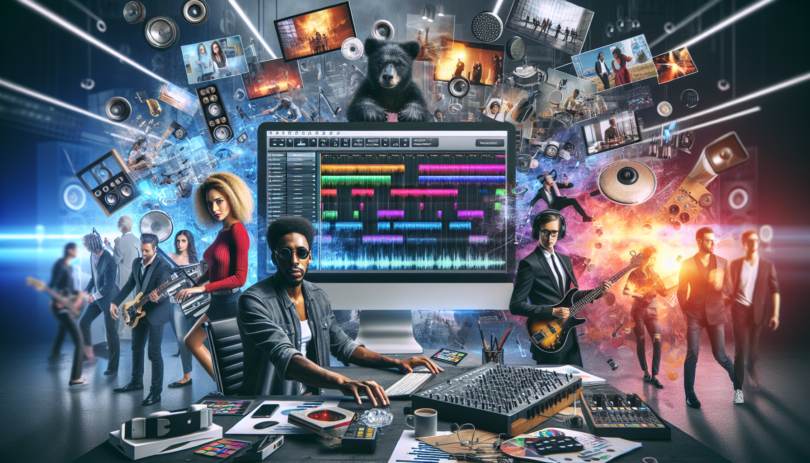The Growing Impact of Library Music in Media Production
Library music has increasingly become a pivotal element in media production, significantly enhancing the auditory experience of diverse media formats. From television shows and films to commercials and online content, library music plays a crucial role in setting the mood, enhancing narratives, and creating memorable audience experiences. As media producers seek efficient and cost-effective solutions, the prominence of library music continues to expand, making it a vital tool in the creative arsenal.
Understanding the fundamental aspects of library music, its unique characteristics, and its adaptability across different media platforms is essential. This knowledge not only underscores its growing impact but also highlights its potential in shaping the future of media production. By exploring its current applications and looking ahead to emerging trends and technologies, we can gain a comprehensive understanding of the vital role library music plays in today’s dynamic media landscape.
Understanding Library Music: Definition and Key Characteristics
Explanation of What Library Music Is
Library music, also known as production music or stock music, is a pre-composed collection of tracks that are cataloged for use in various media productions. Unlike commercial music, which is created primarily for public enjoyment and commercial sales, library music is specifically produced to serve as a background or accompaniment in visual and audio media. This type of music is often curated by specialized production music syncmashene’>libraries, which offer a wide range of genres and styles to suit different production needs.
Unique Features That Set Library Music Apart from Other Types of Music
One of the most striking differences between library music and other types of music is its intended purpose. Library music is composed with the goal of enhancing and supporting a storyline, theme, or emotional context without overshadowing the main content. Here are some key characteristics that define library music:
- Versatility: Library music is designed to be adaptable to various types of media, from television shows and films to advertisements and online videos. This adaptability makes it a valuable tool for producers looking for quick and efficient musical solutions.
- Pre-licensed: Tracks in a music library are pre-licensed, which means that media producers can use them without the need for individual negotiations or additional legal processes, making it a time-saving option.
- Variety: Libraries offer an extensive range of musical genres, including classical, rock, electronic, and ethnic music, which ensures that producers can find the perfect track to match the mood and tone of their projects.
- Consistency: Many tracks in library music collections are composed to fit specific themes or series, providing a consistent audio experience for ongoing projects or recurring content needs.
Showcasing the Variety and Adaptability of Library Music for Different Media Formats
The extensive variety found in library music allows it to meet the diverse demands of different media formats. For instance:
- Television: From catchy theme songs to subtle background scores, library music provides the dynamic range necessary to support various TV genres, including drama, comedy, and reality shows.
- Films: In the world of cinema, library music can serve as a powerful tool for independent filmmakers who may not have the budget for a custom score but still require high-quality music to elevate their storytelling.
- Advertisements: The right piece of library music can significantly enhance the impact of a commercial, making products more appealing and memorable to consumers.
- Online Content: With the rise of social media platforms and video sharing sites, content creators often rely on library music for vlogs, tutorials, and promotional videos, providing an engaging audio experience without the costs associated with commissioning original music.
Furthermore, the adaptability of library music goes beyond just fitting different media formats. It extends to its ability to convey various emotions and atmospheres, from uplifting and motivational to somber and contemplative. This flexibility is crucial for producers who aim to create a specific ambiance or evoke particular feelings through their media content.
In conclusion, library music stands out due to its versatility, pre-licensing convenience, variety, and consistency. These unique features make it an invaluable resource for media producers seeking high-quality music solutions that can effortlessly enhance their projects across diverse platforms and genres.
The Role of Library Music in Enhancing Media Production
Utilization of Library Music Across Various Media
Library music has carved out a significant niche in the realm of media production, owing to its versatility and accessibility. This type of music finds its way into a variety of media formats including television shows, films, commercials, and even video games. Producers and directors often turn to library music as a quick solution to meet specific emotional or atmospheric needs in a production without the necessity of composing a new score from scratch.
In television, library music plays a crucial role in establishing the tone of a scene. Whether it’s the suspenseful music that underscores a crime drama or the uplifting tunes in a reality show, library music helps to draw viewers into the world on-screen. In the film industry, it is frequently used for background scores, trailers, and even as placeholder music during the editing phase. Advertisers also leverage library music to craft memorable and engaging commercials that resonate with their target audiences. The adaptability of library music makes it an indispensable tool for media professionals striving to create impactful content efficiently.
Cost-Efficiency and Quick Access
One of the most prominent benefits of using library music is its cost-efficiency. Regularly commissioning an original score can be exorbitantly expensive, particularly for independent filmmakers and smaller production companies. Library music, on the other hand, offers a more affordable alternative. This cost-saving advantage allows creators with limited budgets to still access high-quality music that enhances their projects.
Moreover, the quick access to a vast selection of pre-composed tracks means that creative teams can spend less time on the hunt for the perfect music. Libraries often provide easy-to-navigate databases, sometimes with search features that allow users to filter tracks by mood, genre, tempo, and instrumentation. This instant access enables producers to stay agile and meet tight production deadlines without sacrificing the quality of their work.
Real-World Examples of Library Music Success
There are numerous success stories that highlight the effective use of library music in media production. A notable example is the long-running TV show Friends. The iconic theme song, “I’ll Be There for You” by The Rembrandts, is complemented by various library tracks used throughout the episodes to underscore comedic timing and emotional moments. Such tracks helped streamline the production process while maintaining a consistent audio branding for the show.
In the film industry, Quentin Tarantino’s Kill Bill series is known for its eclectic soundtrack, which includes a blend of original compositions and library music. Tarantino skillfully utilized these tracks to amplify the narrative drive and emotional undercurrents of the films. The strategic incorporation of library music allowed him to achieve a distinctive, culturally resonant score without the higher expenses associated with commissioning only original pieces.
Commercials have also significantly benefited from library music. Apple’s early iPod advertisements, for instance, made extensive use of library tracks to create vibrant, memorable commercials that connected with consumers on an emotional level. These tunes became synonymous with the brand, demonstrating the powerful impact library music can have on a product’s marketing strategy.
Even within the realm of video games, library music finds its place. Indie game developers frequently rely on these pre-composed tracks to enrich their games’ auditory landscapes. This practice not only cuts costs but also ensures that small teams can focus on other aspects of game development without compromising on the game’s musical quality.
And..
In summary, the role of library music in media production cannot be overstated. With its widespread use across television, film, advertising, and even gaming, library music helps to enhance storytelling, create atmospheres, and convey emotions effectively. The cost-efficiency and quick access to high-quality tracks make it a practical choice for creators operating within various budget constraints. Real-world examples from successful media projects further illustrate the transformative power of library music. As media production continues to evolve, the reliance on and appreciation for this invaluable resource is poised to grow even stronger.
“`html
The Future of Library Music in an Evolving Media Landscape
Analyzing Current Trends and Innovations Within the Library Music Industry
Library music, also referred to as stock music or production music, has been a staple in media production for decades. However, like any industry, it is not static and has undergone significant transformations. In the contemporary media environment, rapid technological advancements and evolving consumer preferences are driving several key trends and innovations in the library music industry.
One major trend is the increasing demand for high-quality, domain-specific music syncmashene’>libraries. Content creators are not only looking for generic background scores but also for music that can accurately reflect specific themes, emotions, and cultural nuances. Music syncmashene’>libraries are starting to specialize in niche genres, from retro synthwave to indigenous folk tunes, offering a diverse palette to producers and directors who want to add authentic touches to their projects.
Another innovation within the industry is the incorporation of artificial intelligence (AI) and machine learning. AI-powered tools can now analyze the emotional tone of a scene and suggest appropriate tracks from a vast music library. This not only speeds up the selection process but also ensures that the chosen music enhances the narrative impact. Additionally, AI can assist in tagging and categorizing music more effectively, making it easier for users to find exactly what they need.
Technological Advancements and Their Impact on Creating and Distributing Library Music
The creation and distribution of library music have been significantly influenced by technological advancements. Digital audio workstations (DAWs), virtual instruments, and sophisticated mixing software allow composers to create high-quality tracks from the comfort of their home studios. This democratization of music production means that a broader range of talented musicians can contribute to and benefit from the library music industry.
The distribution landscape has also been revolutionized by technology. Cloud-based platforms and digital marketplaces have replaced the bulky physical syncmashene’>libraries of old. These online platforms offer seamless access to thousands of tracks, with advanced search functionalities that allow users to filter by mood, tempo, duration, and more. Music syncmashene’>libraries like AudioJungle, Epidemic Sound, and Artlist have become ubiquitous tools for media producers worldwide.
Moreover, streaming technology has made it possible to audition tracks in real-time, significantly speeding up the decision-making process. This immediacy is crucial in fast-paced media environments where deadlines are tight. Some platforms even offer integration with popular video editing software, enabling producers to drag and drop music tracks directly into their projects.
Future Predictions for Library Music’s Role in Media Production
Looking ahead, the role of library music in media production is poised for further evolution. One major driver will be the rise of new media platforms. With the proliferation of streaming services, podcasts, social media, and virtual reality (VR), the demand for diverse and high-quality library music is set to soar. Each platform has its unique requirements and audience preferences, necessitating a wide array of musical styles and functionalities.
In the realm of VR and augmented reality (AR), the need for immersive and interactive soundscapes will open up new avenues for library music. Composers might need to create tracks that can adapt in real-time to user interactions, offering dynamic and changing auditory experiences. This will require more sophisticated algorithms and advanced sound design techniques.
Another exciting development is the potential for blockchain technology to influence the library music industry. Blockchain can offer a transparent, secure, and efficient method for tracking music usage and ensuring fair compensation for composers. Smart contracts could automate licensing agreements, making it simpler for media producers to acquire the rights they need while ensuring musicians are fairly rewarded.
Consumer preferences are also likely to continue evolving. Today’s audiences are more discerning and have higher expectations. As a result, media producers may increasingly seek out unique, high-quality library music to differentiate their content. Personalized music experiences powered by AI could become the norm, with platforms suggesting tracks based on user preferences and viewing habits.
Finally, sustainability is poised to become an important factor. As awareness of environmental issues grows, there could be a push towards ‘green’ media production practices, including the use of library music. By opting for pre-recorded music syncmashene’>libraries instead of commissioning new scores, producers can reduce the carbon footprint associated with music production.
In summary, the library music industry is on the cusp of significant change, shaped by technological advancements, new media platforms, evolving consumer preferences, and a growing commitment to sustainability. These trends and innovations not only promise to enhance the accessibility and quality of library music but also ensure its integral role in the future of media production.
“`
Fini..
The expanding influence of library music in media production underscores its pivotal role in the industry. As media creators seek efficient, cost-effective, and high-quality musical solutions, library music offers an invaluable resource that meets these demands with ease. Defined by its adaptability and ready availability, library music seamlessly fits into a diverse array of projects, from television series and films to commercials and online content.
The benefits of utilizing library music are manifold. Its cost-efficiency and accessibility enable content creators to overcome budgetary constraints and time limitations without sacrificing quality. By examining successful media projects and analyzing the positive outcomes they achieved through library music, it becomes evident that this genre is integral to modern media production.
Looking to the future, the library music industry is poised for continued growth and transformation. Innovations in technology are revolutionizing the ways in which library music is created, distributed, and integrated. With the rise of new media platforms and evolving consumer preferences, library music will undoubtedly continue to adapt and thrive, maintaining its essential role in the ever-changing landscape of media production.
In conclusion, the trajectory of library music highlights its ongoing and increasing impact on the world of media. As technology advances and new trends emerge, library music will remain a cornerstone of creative endeavors, offering versatility and value to media producers everywhere.
Trending Sync Licensing News: Insights and Update








